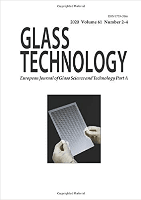
Glass Technology-European Journal of Glass Science and Technology Part A
Scope & Guideline
Pioneering Research in Glass Science for Tomorrow's Technologies
Introduction
Aims and Scopes
- Sustainability and Environmental Impact:
The journal emphasizes research related to sustainable practices and technologies in glass production, including recycling methods, carbon capture, and the development of low-carbon glass products. - Material Science and Engineering Innovations:
Focuses on advancements in glass materials, including properties enhancement, new glass compositions, and innovative manufacturing techniques that improve performance and application. - Applications of Glass in Various Industries:
Explores the use of glass in diverse sectors such as construction, packaging, automotive, and energy, highlighting its versatility and critical role in modern technologies. - Historical and Cultural Perspectives:
Investigates the historical development of glassmaking techniques, cultural significance, and the evolution of glass art, thereby linking contemporary practices with traditional craftsmanship. - Technological Advancements in Glass Processing:
Covers innovations in glass processing technologies, including automation, digitization, and the integration of AI and other cutting-edge technologies in the glass manufacturing process.
Trending and Emerging
- Sustainable Glass Practices:
A marked increase in research focusing on sustainable practices, including recycling, circular economy initiatives, and low-carbon technologies, indicating a strong industry movement towards environmental responsibility. - Integration of AI and Advanced Technologies:
Emerging themes around the application of artificial intelligence, automation, and digital technologies in glass manufacturing processes are gaining traction, showcasing the industry's push for efficiency and innovation. - Functional and Smart Glass Innovations:
Research on advanced functionalities of glass, such as smart coatings, electrochromic properties, and integrated sensors, is becoming more prevalent, highlighting the demand for multifunctional glass solutions. - Adaptation to Climate Change and Resilience:
Increasing focus on how glass materials and technologies can contribute to climate resilience, especially in building and construction applications, is becoming a significant theme in recent publications. - Health and Safety in Glass Production:
Emerging concerns regarding worker health and safety in glass production facilities are leading to more studies on protective measures and technologies, reflecting a growing awareness of occupational hazards.
Declining or Waning
- Traditional Glass Art and Craftsmanship:
There has been a noticeable decrease in papers focusing solely on traditional glass art techniques and craftsmanship, as the industry shifts towards more technology-driven and sustainable practices. - Historical Studies of Glassmaking:
Research related to historical glassmaking techniques and their cultural contexts appears to be waning, potentially due to a growing emphasis on contemporary applications and materials science. - Basic Glass Science and Theory:
Papers that delve into fundamental theories of glass science without practical applications are less frequently published, showcasing a trend towards applied research that addresses current industry challenges.
Similar Journals

Advances in Concrete Construction
Transforming the Future of Concrete InnovationAdvances in Concrete Construction, published by TECHNO-PRESS in South Korea, is a pivotal academic journal dedicated to the fields of Building and Construction, Civil and Structural Engineering, and Mechanics of Materials. Established with the aim of fostering innovative research, this journal has rapidly gained recognition, achieving a commendable Q2 ranking across multiple categories, including Safety, Risk, Reliability, and Quality as of 2023. Featuring a blend of rigorous peer-reviewed articles, the journal serves as a vital platform for scholars, engineers, and students alike to disseminate cutting-edge research and practical applications in concrete construction technologies. Despite its absence of Open Access, the journal's inclusion in Scopus with notable rankings - such as #66 in Building and Construction - underscores its growing influence and commitment to quality as it converges on significant advancements from 2016 to 2024. By contributing to this respected journal, you join a community dedicated to exploring the future of sustainable and efficient construction practices.
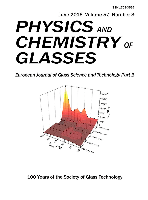
Physics and Chemistry of Glasses-European Journal of Glass Science and Technology Part B
Fostering Knowledge in the Dynamic World of Glass MaterialsPhysics and Chemistry of Glasses-European Journal of Glass Science and Technology Part B is an esteemed academic journal published by the Society of Glass Technology, strategically located in the United Kingdom. With an emphasis on the intricate relationship between physics, chemistry, and the science of glass, this journal serves as a pivotal platform for researchers, professionals, and students who are passionate about materials science and glass technology. Although it currently holds a Q4 ranking in several key categories, including Condensed Matter Physics and Materials Chemistry, the journal's commitment to advancing knowledge in the field is evident through its inclusive exploration of innovative studies from 2006 to 2024. This journal features a range of open access options, promoting wider dissemination of research findings and enhancing visibility for authors. In a rapidly evolving field, Physics and Chemistry of Glasses plays an essential role in integrating theoretical perspectives with practical applications, thus inviting contributions that advance the understanding of glass materials and their functionalities in contemporary technologies.

Journal of Ceramic Science and Technology
Bridging Gaps in Ceramic Science and ApplicationJournal of Ceramic Science and Technology, published by GOLLER VERLAG GMBH in Germany, serves as a vital platform for advancements in the field of ceramics and composites. Since its inception in 2010, the journal has contributed significantly to the scholarly literature, encompassing a wide range of topics including the development of new ceramic materials, nanocomposites, and their various applications in industries such as electronics, energy, and medicine. Although currently categorized in the Q4 quartile of ceramics and composites and ranked within the lower percentile in Scopus, the journal strives to bridge the gap between fundamental research and practical implementation, fostering innovative solutions to contemporary materials challenges. With an open-access format, it ensures that valuable findings are disseminated widely, promoting collaboration and knowledge sharing among researchers, professionals, and students in the field. As it converges towards 2024, the Journal of Ceramic Science and Technology remains committed to enhancing the understanding and utilization of ceramic materials, making it an indispensable resource for those dedicated to advancing this dynamic area of study.
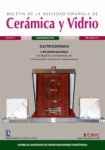
BOLETIN DE LA SOCIEDAD ESPANOLA DE CERAMICA Y VIDRIO
Shaping the Future of Industrial Engineering through Open AccessBOLETIN DE LA SOCIEDAD ESPANOLA DE CERAMICA Y VIDRIO, published by Elsevier, is a premier open-access journal dedicated to advancing research in the fields of Ceramics and Composites, Industrial and Manufacturing Engineering, and Mechanics of Materials. With an impressive impact factor and a strong ranking within its categories—Q2 in 2023 for multiple engineering domains—it serves as a vital resource for academics, industry professionals, and students alike. The journal has embraced an open-access model since 2015, providing widespread accessibility to the latest findings and innovations in ceramic and glass sciences, thus encouraging collaboration and knowledge sharing within the global research community. Published quarterly, and with a focus on interdisciplinary applications, the BOLETIN DE LA SOCIEDAD ESPANOLA DE CERAMICA Y VIDRIO is not only influential in shaping research agendas but also essential for anyone engaged in the evolving landscape of materials science.
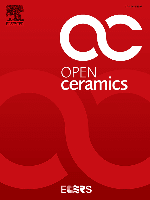
Open Ceramics
Catalyzing Progress in Materials InnovationOpen Ceramics is a pioneering journal published by Elsevier, dedicated to the field of materials science, with a particular focus on ceramics and composites. Launched in 2020, this Open Access journal aims to facilitate unrestricted dissemination of cutting-edge research findings while promoting innovative developments in the utilization of ceramic materials across various applications. As of 2023, Open Ceramics has established a commendable presence in several key categories, achieving Q3 in Biomaterials and Q2 rankings in Ceramics and Composites, Electronic, Optical and Magnetic Materials, and Materials Chemistry. The journal's broad scope appeals to a diverse audience of researchers, professionals, and students interested in the advancements within this essential domain of materials science. With a commitment to quality and relevance, Open Ceramics provides a platform for rigorous peer-reviewed research, thereby enhancing the global dialogue in the field and contributing to the ongoing progress of materials innovation.

Elastomers and Composites
Exploring the Synergy of Elastomers and CompositesElastomers and Composites is a leading academic journal dedicated to the advancement of knowledge in the fields of polymer science and materials engineering, specifically focusing on elastomers and composite materials. Published by RUBBER SOC KOREA, this journal serves as a vital platform for researchers and professionals to disseminate innovative research findings and insights in material properties, applications, and synthesis techniques. Although it currently does not offer open access, the journal provides rigorous peer-reviewed content that enhances the global dialogue on elastomeric materials and their composites, reflecting its commitment to high-quality scholarship. With a strong emphasis on practical relevance and theoretical advancements, Elastomers and Composites aspires to reshape industry practices and academic thought, making it an invaluable resource for students, researchers, and practitioners alike. Positioned strategically within its field, this journal fosters collaboration and dialogue among scientific communities, all while supporting the growth of cutting-edge research programs worldwide.
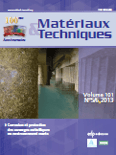
Materiaux & Techniques
Pioneering Research in Material Development and ApplicationMateriaux & Techniques, published by EDP SCIENCES S A, is a prominent journal in the field of materials science, specifically focusing on diverse and innovative techniques in material development and application. With an ISSN of 0032-6895 and an E-ISSN of 1778-3771, this French journal serves as a key resource for researchers and professionals looking to advance their knowledge and share their findings within the community. The journal holds a Q3 ranking in Materials Science (miscellaneous), indicating its role in contributing to various facets of material science research amidst a growing field. Despite operating under a traditional access model, it provides a platform for rigorous peer-reviewed studies and significant advancements in material technology. With a publication history tracing back to the late 1970s and extending through to 2024, Materiaux & Techniques continues to uphold its commitment to fostering high-quality discourse and innovation in materials science.

REFRACTORIES AND INDUSTRIAL CERAMICS
Fostering Excellence in Refractory and Ceramic InnovationsREFRACTORIES AND INDUSTRIAL CERAMICS is a prestigious journal published by Springer, dedicated to the field of ceramics and composite materials. With an ISSN of 1083-4877 and an E-ISSN of 1573-9139, this journal plays a pivotal role in fostering advances in the development, formulation, and application of refractories and industrial ceramics. The journal has been actively publishing since 1996 and is recognized for its contribution to the academic discourse in the ceramics community. Although it currently holds a Q4 ranking in both Ceramics and Composites and Materials Chemistry categories, it serves as an important platform for emerging research trends and innovations, making it essential reading for researchers, professionals, and students engaged in material science. While access is not open, the journal ensures that high-quality research reaches its audience, reflects the evolving landscape of the ceramics industry, and encourages interdisciplinary collaboration.

Journal of Metals Materials and Minerals
Unveiling Breakthroughs in Materials and Mineral StudiesJournal of Metals Materials and Minerals (ISSN: 0857-6149) is a renowned academic publication dedicated to the interdisciplinary fields of metallurgical science, materials engineering, and mineralogy. Published by Chulalongkorn University, Metallurgy & Materials Science Research Institute in Thailand, this journal serves as a pivotal platform for researchers to disseminate their findings and explore innovative applications related to metals, ceramics, polymers, and biomaterials. Although the journal does not currently adopt an open-access model, it provides insightful content that facilitates knowledge sharing among professionals and academics alike. The journal has established its credibility with impressive Scopus ranking percentiles, particularly in categories such as Metals and Alloys and Ceramics and Composites. With an emphasis on advancing the understanding of materials science from 2017 to 2024, the Journal of Metals Materials and Minerals remains an essential resource for those striving to contribute to and stay informed about the latest trends and breakthroughs in these dynamic fields.
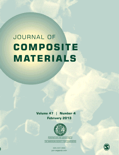
JOURNAL OF COMPOSITE MATERIALS
Transforming Ideas into Composite InnovationsJOURNAL OF COMPOSITE MATERIALS, published by SAGE PUBLICATIONS LTD, is a premier academic journal dedicated to advancing the field of composite materials. With a long-standing history since 1967, this journal serves as a vital platform for researchers and professionals in the areas of ceramics and composites, materials chemistry, mechanical engineering, and mechanics of materials. The journal's impact is further underscored by its Q2 quartile ranking in various categories as of 2023, alongside notable Scopus rankings in multiple engineering and material science disciplines. Though it currently lacks Open Access options, its rigorous peer-review process ensures the high quality and relevance of its published research. This journal is instrumental in fostering innovation and promoting collaboration among academics and industry professionals, making it essential reading for anyone involved in materials science and engineering.